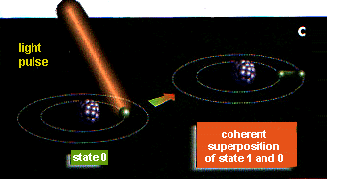 consider an idealised atom with a single electron and two energy levels, a ground state (identified with the value 0) and an excited state (value 1), (cf Fig.(A) caption).
consider an idealised atom with a single electron and two energy levels, a ground state (identified with the value 0) and an excited state (value 1), (cf Fig.(A) caption). Any quantum system with at least two discrete and sufficiently separated energy level is an appropriate candidate for a qubit. So far the most popular qubits among the experimentalists have been atoms of rubidium (ENS experiments) or berylium (NIST experiments). In an atom, the energy levels of the various electrons are discrete. Two of them can be selected and labelled as logical 0 and 1. These levels correspond to specific excitation states of the electrons in the atom.
To see how it is possible to control the two logical values, let us simplify the situation and  consider an idealised atom with a single electron and two energy levels, a ground state (identified with the value 0) and an excited state (value 1), (cf Fig.(A) caption).
consider an idealised atom with a single electron and two energy levels, a ground state (identified with the value 0) and an excited state (value 1), (cf Fig.(A) caption).
Let us imagine that the atom is initially in state 0 and that we want to effect the NOT operation. The NOT operation just negates the logical value so that 0 becomes 1 and 1 becomes 0. This is easily performed with atoms. By shining a pulse of light of appropriate intensity, duration and wavelength (the wavelength should match the energy difference between the two energy levels), it is possible to force the electron to change energy level. In our case, the electron initially in the ground state will absorb some energy from the light pulse and transfer itself to the state  1 (cf Fig. (B) caption). If the electron were initially in the state 1, the light pulse would cause transfer of the electron to state 0.
1 (cf Fig. (B) caption). If the electron were initially in the state 1, the light pulse would cause transfer of the electron to state 0.
Logical NOT, described above, can be understood in completely classical terms , however, we can also perform purely quantum logical operations without any classical analogs. For instance, by using a light pulse of half the duration as the one needed to perform the NOT operation, we effect a half--flip between the two logical states. What does this mean? In substance, it means that operation 0 --->1 is only half performed and that the state of the atom after the half pulse is neither 0 or 1 but a coherent quantum superposition of both states (cf Fig. (C) caption). Just like the photon that travels through both A and B routes, the electron of the atom ``is'' in both 0 and 1 state. Acting on an atom in that state with another half pulse of light will complete the NOT operation, and set it in the 1 state. Because operation NOT is obtained as the result of two consecutive quantum "half--flips'' this purely quantum operation is often called the square root of NOT. Using this kind of "half--pulses'', it is possible to create superpositions of states in the memory of a quantum computers (a memory would, of course, consist of many atoms), opening thus new ways to perform computations. Subsequent logical operations usually involve more complicated physical operations on more than one qubit.
atom ``is'' in both 0 and 1 state. Acting on an atom in that state with another half pulse of light will complete the NOT operation, and set it in the 1 state. Because operation NOT is obtained as the result of two consecutive quantum "half--flips'' this purely quantum operation is often called the square root of NOT. Using this kind of "half--pulses'', it is possible to create superpositions of states in the memory of a quantum computers (a memory would, of course, consist of many atoms), opening thus new ways to perform computations. Subsequent logical operations usually involve more complicated physical operations on more than one qubit.